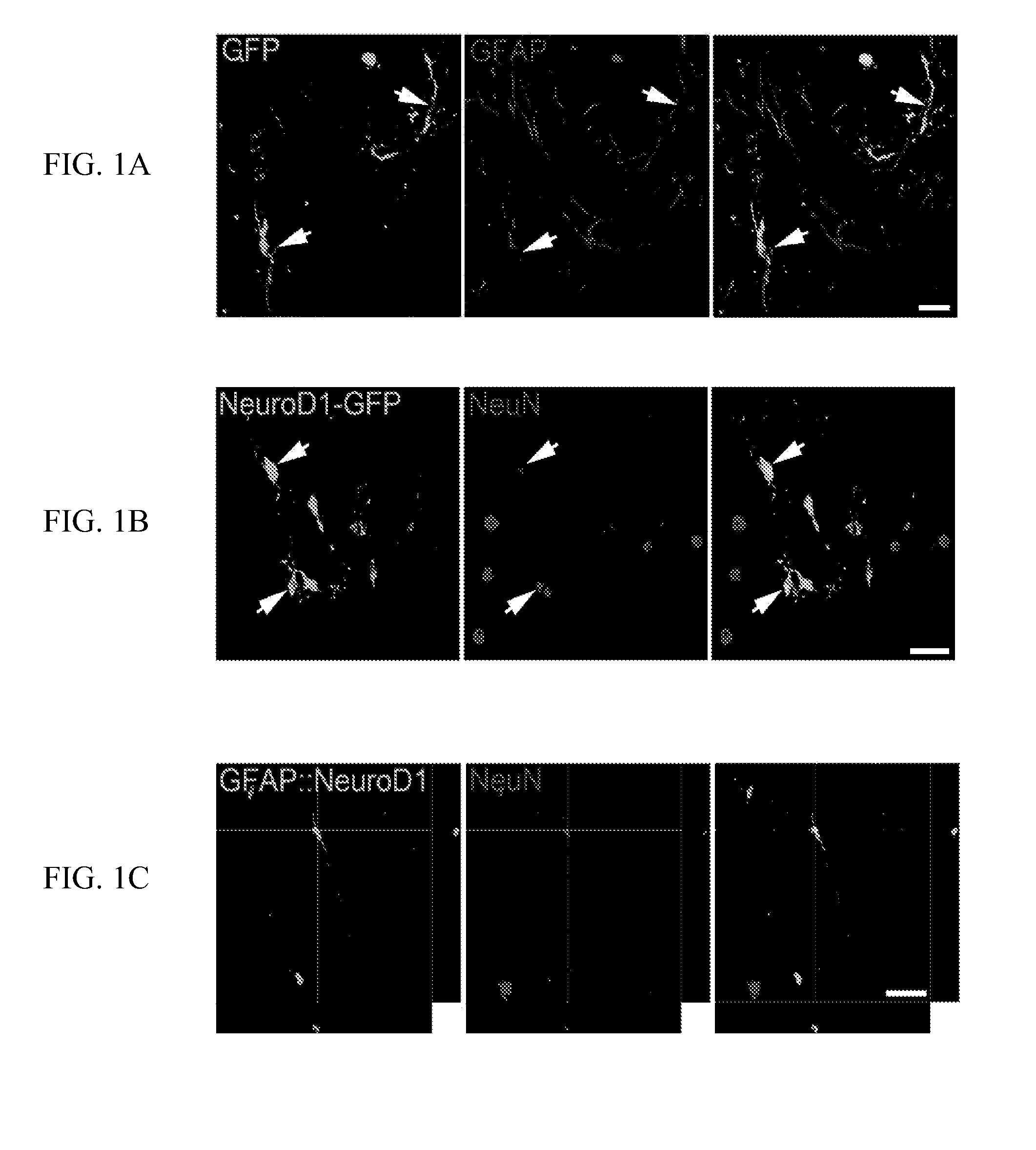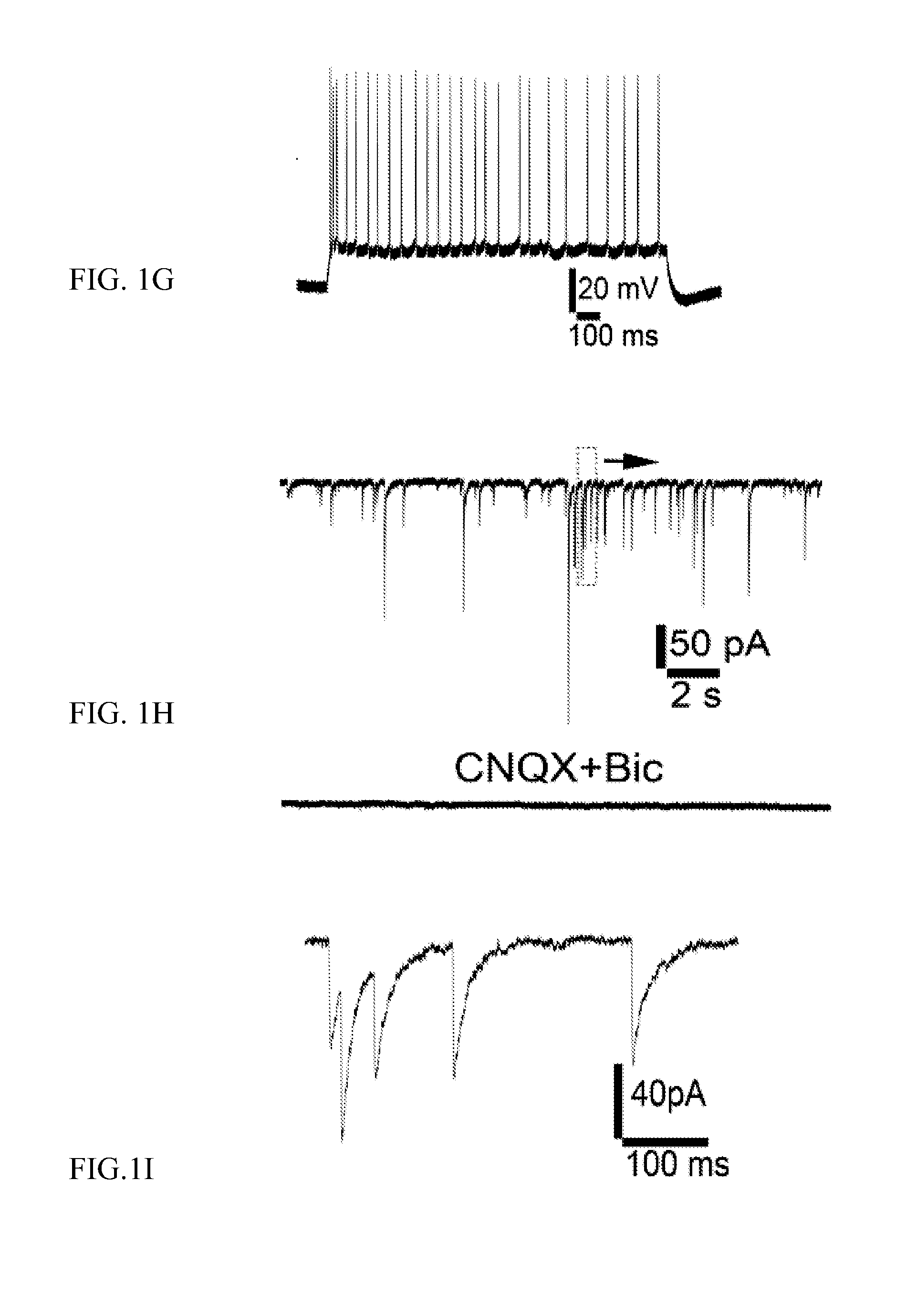Regenerating functional neurons for treatment of disease and injury in the nervous system
a functional neuron and neuron technology, applied in the direction of drug compositions, peptide/protein ingredients, genetic material ingredients, etc., can solve the problem of no method available to reverse glial scars for brain repair
- Summary
- Abstract
- Description
- Claims
- Application Information
AI Technical Summary
Benefits of technology
Problems solved by technology
Method used
Image
Examples
example 1
Mouse Cortical Astrocyte and NG2 Culture
[0271]For astrocyte culture, postnatal (P3-P5) mouse cortical tissue was dissociated and plated onto 25 cm2 flasks. Cells were cultured for 5-6 days, and flasks were rigorously shaken daily to remove neurons and non-astrocytic cells. After reaching confluence, astrocytes were centrifuged for 5 min at 1,000 rpm, re-suspended, and plated on poly-D-lysine (Sigma) coated coverslips (12 mm) Astrocyte culture medium contained DMEM / F12 (Gibco), 10% fetal bovine serum (Gibco), penicillin / streptomycin (Gibco), 3.5 mM glucose (Sigma), and supplemented with B27 (Gibco), 10 ng / mL epidermal growth factor (EGF, Invitrogen), and 10 ng / mL fibroblast growth factor 2 (FGF2, Invitrogen).
[0272]For mouse NG2 culture, the cortical tissue of postnatal mice (P3-P5) was dissociated and plated in 25 cm2 flasks coated with poly-D-lysine (Sigma). The cells were maintained in DMEM / F12 (Gibco) with 10% fetal bovine serum (Gibco) for 9 days, with a medium change every 3 day...
example 2
Human Cortical Astrocyte and Microglia Culture
[0273]Human cortical astrocytes (HA1800) were purchased from ScienCell (California). Cells were subcultured when they were over 90% confluent. For subculture, cells were trypsinized by TrypLE™ Select (Invitrogen), centrifuged for 5 min at 1,000 rpm, re-suspended, and plated in a medium consisting of DMEM / F12 (Gibco), 10% fetal bovine serum (Gibco), penicillin / streptomycin (Gibco), 3.5 mM glucose (Sigma), and supplemented with B27 (Gibco), 10 ng / mL epidermal growth factor (EGF, Invitrogen), and 10 ng / mL fibroblast growth factor 2 (FGF2, Invitrogen). The astrocytes were cultured on poly-D-lysine (Sigma) coated coverslips (12 mm) at a density of 50,000 cells per coverslip in 24-well plates (BD Biosciences). Human primary microglial cells were obtained from Clonexpress, Inc. (Maryland). The cells were cultured in DMEM / F-12 (Gibco) supplemented with 5% FBS, 10 ng / ml of macrophage colony-stimulating factor (M-CSF, Invitrogen), 10 ng / mL epiderm...
example 3
Retrovirus Production
[0274]The mouse NeuroD1 gene was subcloned from the pAd NeuroD-I-nGFP construct, described in Zhou, Q. et al., Nature 455(7213):627-632, 2008 (Addgene) and inserted into a pCAG-GFP-IRES-GFP retroviral vector described in Zhao, C. et al., J. Neurosci., 26(1):3-11,2006 to generate pCAG-NeuroD1-IRES-GFP retroviral vector. The sequence of CAG-NeuroD1-IRES-GFP is shown herein as SEQ ID NO:9. A control retrovirus construct, pCAG-GFP, encodes GFP and not NeuroD1.
[0275]The human GFAP promoter gene was subcloned from hGFAP Promoter-Cre-MP-1 (Addgene) and replaced the CAG promoter to generate pGFAP-NeuroD1-IRES-GFP and pGFAP-GFP-IRES-GFP retroviral vectors.
[0276]The human NG2 promoter was subcloned and replaced the CAG promoter to generate hNG2-NeuroD1-IRES-GFP and hNG2-GFP-IRES-GFP retroviral vectors.
[0277]The mouse Lcn2 promoter was subcloned and replaced the CAG promoter to generate mLcn2-NeuroD1-IRES-GFP and mLcn2-GFP-IRES-GFP retroviral vectors. Reactive glial cells ...
PUM
| Property | Measurement | Unit |
|---|---|---|
| speed | aaaaa | aaaaa |
| flow rate | aaaaa | aaaaa |
| pH | aaaaa | aaaaa |
Abstract
Description
Claims
Application Information
 Login to View More
Login to View More - R&D
- Intellectual Property
- Life Sciences
- Materials
- Tech Scout
- Unparalleled Data Quality
- Higher Quality Content
- 60% Fewer Hallucinations
Browse by: Latest US Patents, China's latest patents, Technical Efficacy Thesaurus, Application Domain, Technology Topic, Popular Technical Reports.
© 2025 PatSnap. All rights reserved.Legal|Privacy policy|Modern Slavery Act Transparency Statement|Sitemap|About US| Contact US: help@patsnap.com



